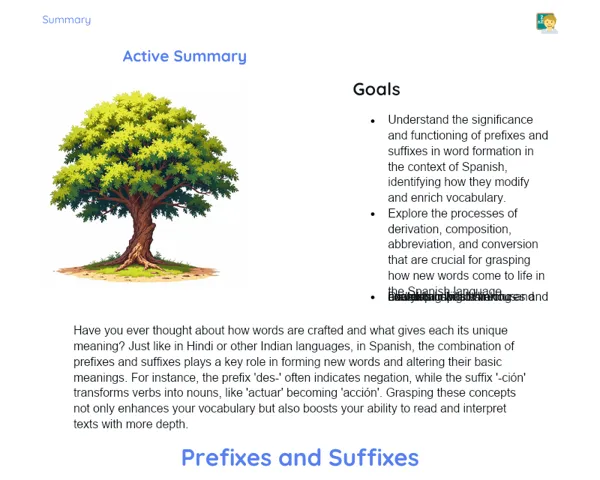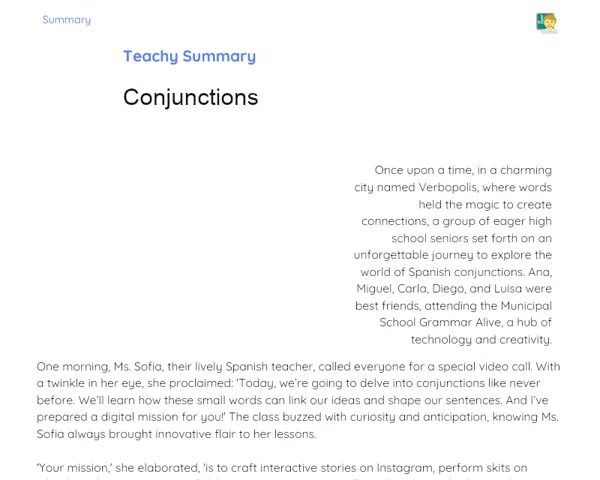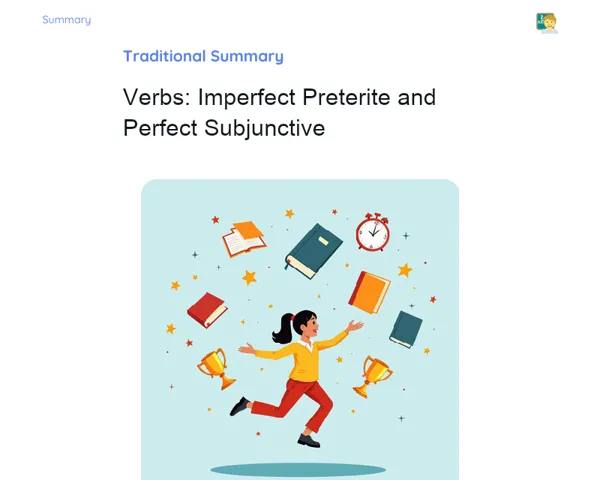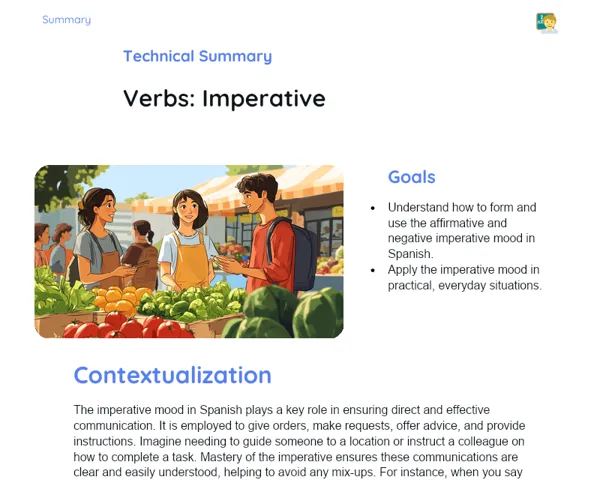Objectives
1. 🚀 Get a firm grip on using future verbal periphrases in Spanish to express actions and events that will unfold ahead.
2. 🔍 Identify and analyse the usage of future verbs across various texts, enhancing your reading comprehension and interpretation skills.
Contextualization
Did you know there are several ways to talk about the future in Spanish? Future verbal periphrases are not just about stating future actions; they also convey predictions, promises, and intentions. For instance, saying 'Voy a estudiar más' means you're not only planning to study more, but you're also pledging to do so. This depth of expression greatly enhances the subtlety and precision of communication in Spanish. Mastering these verbal structures can lead to more effective and culturally vibrant communication!
Important Topics
Future Verbal Periphrases
Future verbal periphrases are unique language structures in Spanish that combine the verb 'ir' (to go) in the present tense with the preposition 'a' and the main verb in its infinitive form. They express future actions but also denote plans, intentions, or expectations. For example, 'Voy a estudiar' translates to 'I will study' or 'I am planning to study,' depending on the context.
-
Formation: Conjugate 'ir' (voy, vas, va, vamos, vais, van) followed by 'a' and the infinitive main verb.
-
Usage: To express plans, intentions, or predictions about the future.
-
Examples: 'Mañana voy a comer con mis amigos.' (Tomorrow I will eat with my friends.)
-
Importance: These structures are essential for daily conversations, often appearing in informal texts and everyday interactions.
Simple Future Verbs
The simple future in Spanish is constructed by taking the verb's infinitive form and adding specific endings for each personal pronoun. It conveys actions that will occur in the future without the nuance of planning or intent provided by future verbal periphrases. For instance, 'Comeré' (I will eat) simply indicates a future action without implying pre-planning.
-
Formation: Add the endings -é, -ás, -á, -emos, -éis, -án to the infinitive verb.
-
Usage: To express future actions directly, without contextual nuances.
-
Examples: 'Viajaré a España el próximo año.' (I will travel to Spain next year.)
-
Importance: This verb tense is commonly used in formal, academic, and literary contexts, providing clarity and structure to future expressions.
Probability and Assumption Verbs
Beyond expressing future actions, future verbs can indicate likelihood or assumptions about events in the present or future. For instance, 'Serán las tres' (It must be three o'clock) implies a supposition about the current time based on observations or prior knowledge.
-
Utilisation of modal verbs like 'deber', 'poder', or 'tener que' conjugated in the future, along with the main verb to indicate probability or assumption.
-
Examples: 'Deben de ser las dos.' (It must be two o'clock.)
-
Importance: This construction is crucial for conversation, helping to articulate doubts, probabilities, and certainties in Spanish.
Key Terms
-
Future Verbal Periphrases: A combination of the verb 'ir' in the present tense with an infinitive to indicate future actions.
-
Simple Future: A verb tense formed by the infinitive and specific endings according to each pronoun.
-
Modal Verbs: Verbs that modify the meaning of others, generally reflecting possibility, obligation, or permission.
For Reflection
-
How can choosing between future verbal periphrases and the simple future change the meaning or interpretation of a sentence? Think of practical examples.
-
How can the use of probability and assumption with modal verbs in the future enhance communication and comprehension in day-to-day situations?
-
Why is it important to understand and accurately apply these verbal structures for fluency and clarity in Spanish communication?
Important Conclusions
-
Today, we delved into the fascinating world of Future Verbal Periphrases in Spanish, an engaging way to articulate future actions and intentions. We learned how to meld 'ir' with another verb's infinitive to create meanings that surpass a mere future statement.
-
We explored the Simple Future, which provides a more straightforward means to express future actions, perfect for formal and academic contexts, and the role of modal verbs in expressing probability and assumptions.
-
We acknowledged that the choice between these structures involves not just grammar but also effective and culturally appropriate communication, enriching our expression and understanding in Spanish.
To Exercise Knowledge
Create a dialogue between two friends planning a future event. Use both future verbal periphrases and the simple future to distinguish between planned intentions and direct actions. Don't forget to include modal verbs to express probabilities about the event. Present your dialogues in the next class for a group discussion.
Challenge
Time Traveler Challenge: Write a letter to yourself, dated one year ahead, outlining what you hope to achieve in your Spanish learning journey. Employ the verbal structures we've covered to discuss your plans, challenges, and triumphs. Keep these letters safe and revisit them in a year to assess your progress!
Study Tips
-
Practice regular writing, be it through diaries or blogs in Spanish. Aim to incorporate various verbal structures, including those we've learned today, to enhance your fluency and expression.
-
Watch Spanish films or series with subtitles in the original language. Pay close attention to the verb forms characters use to discuss the future, and try to replicate these structures in your conversations.
-
Form study groups with friends who are also learning Spanish. Discuss future-related topics and use the language to plan activities together, making the practice of future verbal structures enjoyable and practical.



